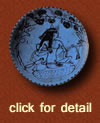Life of Early Egyptians (2160-1994 BC) Middle Kingdom
Many traditional cultures also use tattoos on the flesh as a sort of passport
to the world after death, although interestingly, with all the emphasis on the
next world in ancient Egyptian culture, there is no indication that this was the
case there.
Egypt
is generally accepted as the cradle of tattoo art and by the Middle Kingdom
tattoos seem to have been popular and culturally acceptable
|
|
2,000 BC to 3,000 BC
Several mummies
have been recovered that date to as early as the XI Dynasty (2160-1994 BC)
that exhibit tattoo art forms. One of the most famous of those early mummies is that of
Amunet, a priestess of the goddess Hathor, who was found at Thebes. This female mummy
displayed several lines and dots tattooed about her body. The tattoo patterns and markings were
still clearly visible on her flesh. |
Several other female mummies from this period show similar tattoos in
addition to ornamental scarring (cicatrization) which is still popular today in
some parts of Africa across the lower part of the abdomen. The series of dots
and dashes held protective and fertility promoting significance. The lozenges
are connected to the primal female power of the universe - motherhood.
The traditional reasons for tattooing include:
• to connect with the Divine.
• as a tribute or act of sacrifice to a deity.
• as a talisman, a permanent amulet that cannot be lost.
• to provide magical or
medical protection.
Certainly, the connection between tattoos and the divine existed in ancient
Egypt.
Beyond the geometric designs that were favoured, other designs discovered
were found that were intrinsically connected to religion. Mummies dating from
roughly 1300 BC are tattooed with pictographs symbolizing Neith, a prominent
female deity with a militaristic bent. These are the only tattoos that at this
point seem to have a link with male bearers.
 The God Bes
The God Bes
The earliest known tattoo with a picture of something specific, rather than an abstract pattern, represents the god Bes. Bes is the lascivious god of revelry and he served as the patron god of dancing girls and musicians. Bes's image appears as a tattoo on the thighs of dancers and musicians in many Egyptian paintings, and Bes tattoos have been found on female Nubian mummies dating from about 400BC.
Tattoo Museum Bibliography, Resources and Links
 See all African Tattoo Culture Articles here
See all African Tattoo Culture Articles here
Additional Resources
Ancient
Egyptian Tattoos -- Written records, physical remains, and works
of art relevant to Egyptian tattoo have virtually been ignored by
earlier Egyptologists influenced by prevailing social attitudes toward
the medium.
Beauty
Secrets of the Egyptians -- Tattoos in Ancient Egypt, this
article is devoted to ancient and permanent body adornment.
